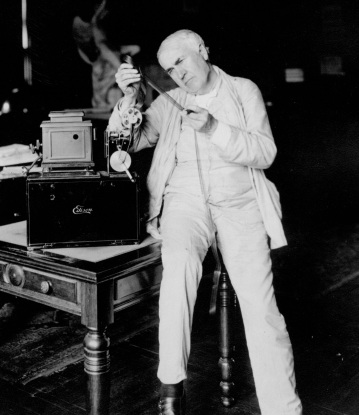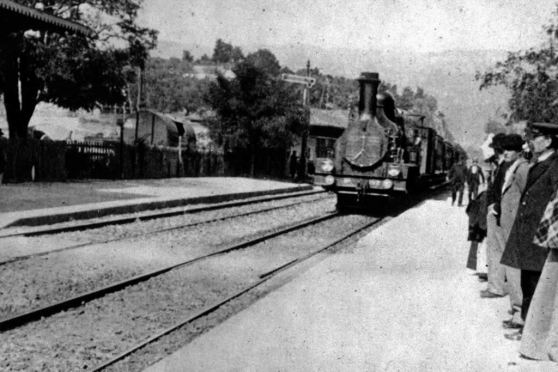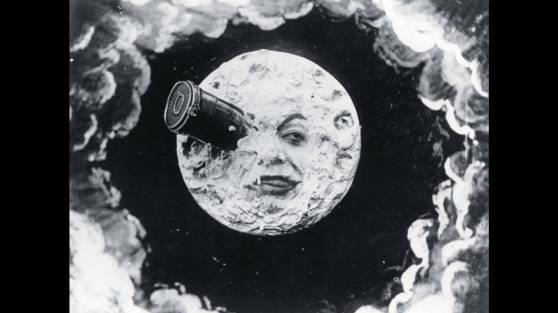Motion Pictures / Moving Images: A Brief History
There’s the common question. Which came first; the egg or the chicken? In the same sense the question applies here as well. Which came first animation or the movie?
Before there were films or movies there were photographs. Not the kind that you and I know today. These photographs were grainy and black and white, some even sepia or red and cream colored. It was because of photographs that we were able to have films and movies; however back then they weren’t called movies but moving pictures or motion pictures.
Now moving images are the illusion that’s created when still images display very quickly. This is caused by the Persistence of Vision. A phenomenon that happens when one’s eyes and brain see two or more images very quickly within a sequence. Your eyes use their ability to blend images as one causing the brain to perceive it as smooth movements.
It all started with an idea and moved on to something grand, an invention, several actually. Over hundreds of years there have been many inventors from all over who have contributed to the creation of motion picture films.
Philip James de Loutherbourg was a French painter born in Germany.
In 1781, Loutherbourg invented the Eidophusikon which was a mini theater that used mirrors and pulleys and contained animated panoramas created by presenting several paintings in accordance to the principle of Camera Obscura.
Now a Camera Obscura is both a form of projector and a principle following a law of optics ruled into one. Light travels in a straight line; when some of the rays reflected from a bright subject pass through a pinhole in thin material on one wall into a darkened room, they cross and reform as an inverted image on a flat surface of the wall parallel to the hole.
At first Camera Obscuras were dark rooms that later became a portable box device that was used as a drawing table. Convex Lenses were added to improve quality and shortly after a mirror was added to reflect the image. Thus Camera Obscuras became the first photographic cameras using a sheet of light sensitive material.
In 1825 John Parris invented the Thaumatrope, a device with separate pictures displayed on both sides of a disk that’s attached by a piece of string on both ends.
The viewer would hold both strings between their fingers and quickly twirl the device causing the two pictures to appear as one image due to the Persistence of Vision.
In 1829 a Belgian man by the name of Joseph Plateau invented an early animation device under the principle of Persistence of Vision.
The device was the Phenakistoscope, which means “spindle viewer”, and contained a series of images and slits on a spinning disc which was attached vertically to a handle or stand and used while looking through the slits in front of a mirror. A mirror was needed in order to display the illusion to the viewer.
William Horner invented the Daedaleum,  meaning “devil’s wheel”, in 1833.
meaning “devil’s wheel”, in 1833.
Daedaleums were small mechanical machines shaped like cylinders or circular drums with images pasted inside.
People would turn a crank in order for Daedaleums to move; once started the device would spin like a tiny merry-go-round.
Multiple slits located on the drum’s upper half allowed users looking through the slits at a certain angle to view the inside images which appeared to be moving.
The Daedaleum allowed many to view it at the same time.
 In 1834 the device was renamed Zoetrope, meaning “wheel of life”.
In 1834 the device was renamed Zoetrope, meaning “wheel of life”.
Coleman Sellars invented the Kinematoscope in 1861.
The device contained a series of still stereo-graphic images in chronologically sequential stages of action displayed upon spinning blades which were viewed through slits passing under a stereoscopic lens in the eyepiece.
John Barnes Linnett realized the possibility of displaying images in a linear sequence as opposed to rotating discs or drums. In 1868 he patented the first flipbook, calling it the Kineograph, which was the first type of animation to use images in the form of a booklet.
In 1877 Charles-Émile Reynaud invented the Praxinoscope.
The device was similar to the Zoetrope in design; however the Praxinoscope used mirrors placed within the middle of drum to reflect passing images, simplifying the viewing process.
Etienne-Jules Marey, a French inventor, invented the first portable movie camera in 1882.
It was called the Chronophotographic Gun.
– Shaped like a rifle
– Took rapidphotographs


Images taken with the Chronophotographic Gun

Eadweard Muybridge was a British inventor and photographer.
Muybridge was in a stage coach crash putting him into a coma shortly after waking he decided he wanted to be a photographer and left for America in 1860.
While in America he became Director of Photographic Surveys for the United States Government in 1868.
Muybridge also shared ideas and worked closely with Etienne-Jules Marey and Thomas Edison.
Muybridge invented the Zoopraxiscope in 1879, which presented a series of images on a disc that was meant to spin like a record.
Mule Bucking and Kicking – 1893
Other Works

Leland Stanford, former governor of California, made a $25,000 bet with a doctor about whether there was a moment in a horse’s gallop when all four hooves were off the ground.
– Stanford owned two horse racetracks in Palo Alto, CA and Sacramento, CA as well as a stock farm in Palo Alto, CA.
He commissioned Eadwaerd Muybridge in 1872 at his stock farm in Palo Alto, CA. Muybridge was to test and prove Stanford’s theory of a horse in motion by photographing several of Stanford’s horses, three of which were Occident, Abe Edgington, and Sallie Gardner.
The first of the horses involved with the experiments was Stanford’s trotter, Occident, at the Palo Alto stock farm. Occident was used to test the theory that a horse had, at some stage, all four hooves off the ground while in a trotting speed. During this time Muybridge developed his techniques and methods of capturing the horse’s movements. He would lay out a series of cameras parallel to the path of the horse that were connected to a series of tripwires on the course and as the horse ran by, it would set off these tripwires which would activate the cameras.
On July 1, 1877 at Union Park Racetrack, in Sacramento, California, Muybridge completed his experiments with Occident. In doing so Muybridge developed an “automatic electro-photograph” a method which captures a crisp image “with a shutter speed of less than a hundredth of a second”. The retouched pictures of Occident was published later on in the month and created a slight sensation.
Within the next year Muybridge started setting up a series of 12 cameras equipped with the electromagnetic shutters of his own invention. These next series of tests involved Stanford’s prized trotting horse, Abe Edgington at the stock farm in Palo Alto, CA and were to test the horse’s different stages of trotting. Research was completed showing great results; and on June 15, 1878 at the Palo Alto Racetrack, Muybridge held a conference of press and horse racing enthusiasts to witness Abe Edgington and Muybridge’s cameras in action. He later used 24 cameras and repeated these experiments.
After further improving his methods and inventions, Muybridge worked with Sallie Gardner, the third of Stanford’s horses. On June 19, 1878 at the Palo Alto Racetrack, Muybridge used electro-shutters and timers, his latest devices, to take multiple series of 6, 8, or 12 phases of Sallie Gardner running down the track. By using these images Muybridge managed to piece them together and come out with the motion picture clip The Horse in Motion in 1882.
The Horse in Motion – 1882
Thomas Edison was a director of films and a maker of flip books.
He invented the Kinetoscope in 1891, which was an early motion picture viewing device.
The Lumière Brothers were famous French inventors. Auguste and Louis Lumière invented movie cameras and projectors. The Lumière Brothers also invented the Kinora, mechanical flipbooks, in 1897.
In 1896 the two went on to show Arrival of a Train at La Ciotat, which was the first movie shown to the public. The film clip was originally made in 1895 and lead to the birth of movies!
Arrival of a Train at La Ciotat – 1896

Georges Melies was a French illusionist and filmmaker famous for being a leader of many key technical and narrative developments in the earlier days of cinema.
He is well known for adding color to clips of film and for his special effects.
Today the movies we take for granted or turn our noses up because of poor or average quality were actually considered a miracle even magic back in the day. Several brilliant men came up with many bright inventions to make motion pictures become a reality.
Sources/References/Further Information
This section here is to reference to sites in which information about the inventions and inventors can be found.http://www.tate.org.uk/whats-on/tate-britain/exhibition/eadweard-muybridge
http://viz.dwrl.utexas.edu/content/window-time-eadweard-muybridges-horse-motion
http://fliptomania.com/did-you-know/
http://www.flipbook.info/history.php
http://lostonsite.com/2010/12/20/cuando-se-capta-el-vuelo-de-un-caballo/
http://www.engadget.com/2008/12/06/sony-builds-massive-bravia-drome-in-italy-to-showcase-240hz-moti/
http://www.moma.org/collection/artist.php?artist_id=4192
http://www.stephenherbert.co.uk/mFORMATS.htm
http://www.eadweardmuybridge.co.uk/muybridge_image_and_context/animal_in_motion/
http://www.wired.com/2009/06/dayintech_0615/
https://www.prestocentre.org/eadweard-muybridge-horse-motion
https://alumni.stanford.edu/get/page/magazine/article/?article_id=39117
http://www.1800techgallery.com/articles/the-beginning-of-cinema.html
http://film-storyboards.com/praxinoscope/
http://brightbytes.com/cosite/what.html
http://www.1800techgallery.com/articles/the-beginning-of-cinema.html









